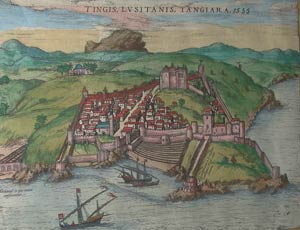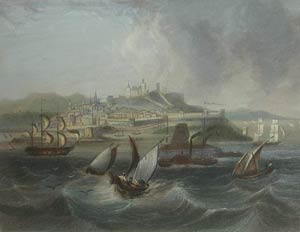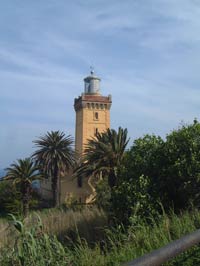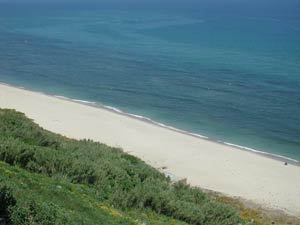|
 The
Portuguese captured Tangier in 1471, and held it for over a century. Consequently,
sailors like Duarte knew its coastline well. The
Portuguese captured Tangier in 1471, and held it for over a century. Consequently,
sailors like Duarte knew its coastline well.
His
careful description of surrounding towns and waters attest to the missions
he conducted, surveying the coast and reporting to military and commercial
ships.
Map
of Tangiers in 1535
 Tangiers
had been a difficult city to capture (the Portuguese tried twice before
succeeding in 1471) and they were not about to let it go! Tangiers
had been a difficult city to capture (the Portuguese tried twice before
succeeding in 1471) and they were not about to let it go!
Given
the strategic importance of Tangiers, the city controlling the furthest
western point of the Gibraltar Straight, many a Portuguese ship came to
dock in its nearby waters. Here are the descriptions Duarte gives of the
coast, both North and South of the Cape Spartel:
"
The whole coast line between Ceuta and Spartel is a succession of very
high mountains. Along the coast, the waters are so deep that boats can
only set anchor close to land.
Beyond Spartel, the coast line is flat, and the waters are shallow,
without rocks, making it easy to set anchor." (Duarte,
234)

The
most prominent landmark on the Tangiers coast was the Cape Spartel, the
furthest reaching point into the Mediterranean. Today, a century old lighthouse
marks the cliff, its 20 second rotation well known to all ships crossing
Gibraltar.
A few miles from the lighthouse, on the road back to Tangiers, the elegant
"Montagne" neighborhood displays its endless rows of villas
and palaces, all remnants of the great 'international days' - an epoch
which brusquely ended with Moroccan independence in 1956. Yet, 50 years
of more modest life styles have not erased the memory of huge mansions,
extravagant lifestyles and tremendous wealth. Tangier's 1920's tycoons
were perhaps the only pirates the city every really housed!
 The
city' role should not however be underestimated in Pirate history. Tangier
was a port of arrival for many a Spanish Jew or Muslim, fleeing from Christian
persecution. "Jew's beach" at the foot of the Kasbah owes its
name to the many refugees who landed there in the late 15th and early
16th century. The
city' role should not however be underestimated in Pirate history. Tangier
was a port of arrival for many a Spanish Jew or Muslim, fleeing from Christian
persecution. "Jew's beach" at the foot of the Kasbah owes its
name to the many refugees who landed there in the late 15th and early
16th century.
These refugees played a central part in the transfer of naval knowledge
and technology to Moroccan corsairs.
|